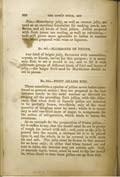These constitute a species of jellies never before introduced to general notice: they are prepared in the first instance nearly in the same manner as directed for making all the preceding fruit jellies, with this difference, that when fruit or liqueur jellies are intended to be partially frozen, two-thirds only of the usual quantity of isinglass must be used; while it is necessary to add one-third more of sugar, to compensate for the action of refrigeration, which tends to lessen the sweetness.
As an example for the preparation of frozen jellies,— let it suffice to say, that the mould must be set in plenty of rough ice mixed with salt; and, soon as the jelly is poured into the mould, a stewpan lid is to be placed upon it, and the whole is to be covered in with more ice and salt. The jelly must be frozen in this manner for an hour only; in order that when turned out and sent to table, the interior may yet remain soft. Cold, or scarcely tepid, water, must be used to dip the mould in, when about to turn these jellies out on their dish.
